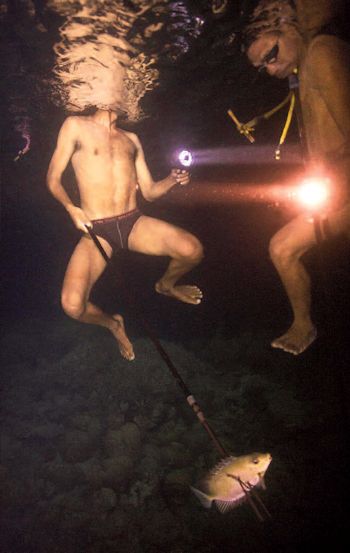SEJournal Online is the digital news magazine of the Society of Environmental Journalists. Learn more about SEJournal Online, including submission, subscription and advertising information.
Feature
By ROGER ARCHIBALD
 |
|
Using flashlights, Papua New Guinea fishermen "dodge tiger sharks and saltwater crocodiles to spear small fish at night," the Sea Change series reported. "I was scared a couple of times, especially during night dives," photographer Steve Ringman admitted, but "Craig (Welch) always watched my back underwater." For many more photos accompanying this story, download the SEJournal PDF (see page 12). |
Steve Ringman started out his career in photography using a 4" x 5" view camera that traces its roots back to the cameras using glass plate negatives that became popular during the Civil War era.
And yet in 2014 he became the first photographer to win SEJ’s prestigious Kevin Carmody Award for Outstanding In-depth Reporting. How? He embraced multimedia.
Ringman and reporter Craig Welch of the Seattle Times took first place for large market publications with their series entitled "Sea Change: The Pacific's Perilous Turn," about the impact of ocean acidification at a number of locales around the Pacific Rim. The report also took first prize for explanatory reporting in the Online News Association 2014 awards.
Their global reporting grew out of a local story the two had covered four years earlier from the southwest Washington coast, where, according to Ringman, “an upwelling of ocean waters had killed all the young oyster larvae, destroying a full year of production.”
It was during the course of that story when they realized that ocean acidification was worldwide in scope. It inspired them to pursue the broader story, with the help of a $19,000 travel grant from the Pulitzer Center on Crisis Reporting.
A 30-year veteran news shooter of the old school when photographers returned from assignment only to disappear into a darkroom to 'soup' their film and make prints, Ringman could well have become the poster child for obsolescence in the newsroom, had he not made the effort to embrace multimedia.
"Never in my wildest dreams did I think shooting stories with large sensor digital video cameras would be in my future," he recalled. Now, video constitutes a significant portion of his daily work assignments.
"I was the first photographer to start shooting video at the paper when the revolution began many years ago," said Ringman. "Since then, times have changed dramatically. … Anyone that is now hired as a photographer has to know how to shoot video as well." But, he added, "It's finding the time and skills to edit video that has been the challenge for some of us who have been here a long, long time — like me."
The transition to digital was not the only obstacle Ringman has overcome. When planning with Welch to report on ocean acidification, they realized they would have to accompany scientists working under water. The problem? Neither of them had diving experience.
But that didn’t stop them. Said Ringman: "We quickly were certified to dive in our freezing Pacific Northwest waters, so we could launch into the 85 degree, crystal clear waters of Papua New Guinea for reporting and shooting." Not a bad incentive.
Roger Archibald is the SEJournal photo editor.
* From the quarterly newsletter SEJournal, Fall 2014. Each new issue of SEJournal is available to members and subscribers only; find subscription information here or learn how to join SEJ. Past issues are archived for the public here.












 Advertisement
Advertisement 



